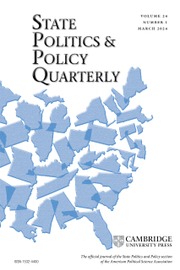No CrossRef data available.
Article contents
Just Say No: The Diffusion of Drug Testing for Welfare Proposals across US States
Published online by Cambridge University Press: 14 April 2025
Abstract
Existing research shows a significant relationship between state racial minority population, the proportion of racial minority welfare recipients, and state levels of racial resentment with the proposal and adoption of punitive welfare policies. This article contributes to the extant literature by expanding on Ledford’s (2018) 2008–2014 analysis of state drug testing proposals by evaluating state-level racial factors and the diffusion of drug testing proposals from 2009 to 2018. Moreover, the author accounts for the potential influence of drug-related variables on the proposal probability by including variables measuring opioid overdose deaths and illicit drug use estimates. Event history analyses do not find that the size of a state’s Black population or the percentage or proportion of Black welfare recipients significantly affects the proposal rates. However, higher estimates of state-level racial resentment increase the likelihood of proposing drug testing for welfare legislation, supporting Ledford’s conclusion that racial biases matter in the diffusion of these policies. In addition, the author has found evidence that while opioid overdoses are negatively associated with the likelihood of proposal, estimates of illicit drug use have the opposite effect. Finally, analyses suggest that liberalism in state governments actually increases the probability of a proposal.
Keywords
- Type
- Original Article
- Information
- Copyright
- © The Author(s), 2025. Published by Cambridge University Press on behalf of the State Politics and Policy Section of the American Political Science Association


